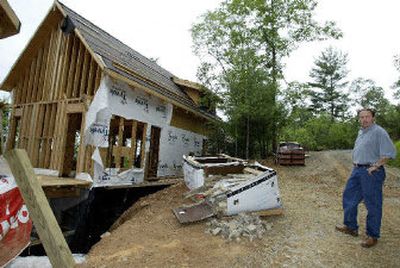Second homes booming

MARBLE, N.C. — On a hillside at the remote western tip of North Carolina, real estate agent Joey Reid is showing off the next big thing in this area’s booming market for vacation and retirement homes.
With 10-foot ceilings, stone fireplaces and screened decks with a mountain view, homes at Black Rock Falls are expected to fetch prices from $300,000 to $500,000. Owners will share access to a natural waterfall, adjoining trails and a clubhouse overlooking the falls.
“It’s a Baby Boomer’s playground,” said Reid as he walked a visitor through the first house in the development, currently under construction.
Black Rock Falls will be the first upscale vacation development in this town where modest vacation homes now sell for $160,000 to $250,000, a four hour-plus drive from Charlotte, N.C.
Across the country, previously unheralded communities are being transformed by a boom in second home purchases fueled by demographics, cheap loans and a real-estate market some believe is in a bubble.
Atlantans priced out of the hot north Georgia mountains and Floridians disillusioned by that state’s rampant growth are behind the boom in Marble and nearby Murphy, N.C. In Oregon, low interest rates and high equity in the San Francisco Bay Area have drawn many retirees and second homeowners to white-hot Ashland, a perennial on various best-places-to-live lists. And in scenic Paonia, Colo., vacation homes are attracting buyers with prices that are half those of comparable dwellings in Snowmass or Aspen, where a one-bedroom condo was listed for $370,000.
“We say the billionaires pushed the millionaires out of Aspen and they ended up in Carbondale,” former mayor and Paonia native Ron Rowell said, referring to another trendy Colorado second-home destination. “Now they’ve been driven over here.”
Nationally, a record 2.82 million second homes sold in 2004 — 1.8 million as investments and just over 1 million as vacation homes — a 16.3 percent increase, according to the National Association of Realtors. In all, 36 percent of all homes purchased in 2004 were either for investment or vacation.
Three factors are driving the surge, said Jeff Lyons, general manager for the Charlotte-based Web site realestate.com: Aging, wealthy baby boomers approaching retirement age, heightened interest in real estate investing, and continued low interest rates.
Those historically low rates, combined with expanding wealth among the upper ranks of American workers — itself often a result of home equity built up due to the hot real-estate market — have made second homes that were once a luxury a reality for more people. And baby boomers are trading the home equity built up in high-priced cities for retirement in cheaper towns.
To accommodate the growth in demand, developers are turning to places where luxurious second homes might seem out of place. Murphy, the Cherokee County seat, is so remote that anti-abortion bomber Eric Rudolph hid out in the nearby mountains, successfully avoiding capture for five years.
“Newly wealthy, newly ready to plan for the next stage, baby boomers are seeking out amenity-filled retirement areas with access to nature, and smart developers are providing them,” Susan Wachter, a professor of real estate at the University of Pennsylvania’s Wharton School, said in an e-mail interview.
Just outside Murphy’s historic downtown are the mountains, with more than 93,000 acres protected inside Nantahala National Forest. Lake Hiawassee, which pools behind a Tennessee Valley Authority-owned dam, has 6,280 surface acres of fishing and miles of shoreline closed to developers.
Cherokee County is remote from the rest of North Carolina, but just 2 1/2 hours from Atlanta. But the bulk of second homeowners here come from Florida. Many are so-called “halfbacks” — folks who moved to Florida from the Rust Belt 20 or 30 years ago but came “halfway back,” disillusioned with their adopted home’s weather, sprawl and cost of living.
Linda Hunt, 45, a sheriff’s dispatcher from Naples, Fla., has vacationed in Murphy for several years with her boyfriend, semiretired electrician Tom Meggers, 59. They plan to relocate permanently in the years ahead.
“I like that it doesn’t have the traffic” of Naples, Hunt said. “We like the climate.”
“I came here because I didn’t want to see any more dump trucks,” Meggers joked.